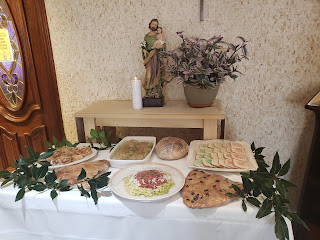Fougasse (French flat bread)
This past weekend, we celebrated St. Joseph's Day. I prepared my traditional altar in thanksgiving for his many prayers and favors. Sunday, though, was a return of the Jefferson Parish Irish-Italian parade.
After a 2 year hiatus (thanks a lot, Covid!), the streets were filled with friends and neighbors, marching bands, walking and dancing groups, and of course, floats. This is no "ordinary" parade. Yes, revelers in costume throw beads and trinkets. But in keeping with traditions surrounding St. Joseph in the New Orleans area, they also throw food. I know you are picturing a middle-school food fight. No. We're talking produce, bags of chips, granola bars, packets of dried ramen, and cookies. We caught carrots, cabbages, onions, and garlic, as well as the aforementioned snacks, enough to fill a wagon.
It is not a boiled-to-oblivion soggy version. The vegetables stay light and crisp, heated gently at the last minute in a flavorful garlic ginger broth. This was first on the menu. To go with this delightful soup, I made fougasse, the French version of the Italian focaccia. This bread takes a bit of planning, but is worth every bit of effort. I made this version with sourdough. Make the dough 2 days before you plan to bake.
The hallmark of fougasse is the leaf shape. The slits representing stem and veins are more than mere decoration. They contribute "extra crust," a real bonus.
During the pandemic, I started baking sourdough bread. Bread is not complicated. It is four ingredients (Ken Forkish's bread book lists them in the title: Flour, Water, Salt, Yeast). Sourdough requires "starter," which is sort of a pet made with flour and water. It contains natural yeast that is grown and fed over a 6 day process. If you know a home baker, they may have starter to share. If not, I'll describe the process, but if you are wanting bread in less than a week, you can use commercial dried yeast.
To make sourdough starter, combine 1 cup of flour with 1/2 cup of water. Mix completely, scrape into a wide mouth 1 quart Mason jar or similar container and cover with a damp towel. Let it sit at room temperature. This is Day 1. Now, every day for the next 5 days (Days 2-6), discard all but 1/2 cup of the mixture, add another 1/2 cup water and 1 cup of flour. Mix well and cover with a damp towel, and ignore it for another 24 hours. By Day 6, your pet should be active and bubbling and ready to use in any recipe that calls for sourdough starter. From this point on, keep it in the refrigerator, and feed it once a week, discarding all but 1/2 cup and mixing it with 1/2 cup water and 1 cup flour.
*1/2 cup of starter with 1 cup water (or 2 tsp dried yeast and 1 and 1/2 cup warm water),
*1 and 1/2 tsp salt
*3 to 3 and 1/2 cups flour (in dry climates, less will be needed, so start with 3 cups and add more if the dough seems too "loose." It should be tacky but not soupy). I have used all purpose, bread flour, and a mixture of 1/4 whole wheat to 3/4 white, as well as gluten-free. It all works, but you should consider that gluten-free blends tends to be "thirstier" than wheat based flour, and the dough will not have the characteristic stretch.
Cover the bowl with a damp towel and let this mixture rest for 30 minutes. This allows the wet and dry ingredients to equalize throughout the mixture ("autolyse").
This one is sprinkled with rosemary and pink Himalayan salt. You can see the air bubbles under the dough. After its 30 minute nap, stretch and fold the dough from top to center, turn the bowl and repeat so that the dough has been through a series of stretches and folds all the way around. Rest, covered, another 30 minutes. Repeat the fold/rest sequence 4 times.
At this point, cover the bowl with plastic wrap and place in the refrigerator for 16 to 48 hours.
1 hour prior to baking, remove the dough from the fridge and rest at room temperature for 30 minutes. During this time, preheat the oven to 450F. If you use a baking stone, place it in the oven first. Turn the dough out onto a floured surface. I use parchment paper so that I can shape the dough and transfer it to the oven without over-handling it. Cut the dough in half. Shape each half (on its own sheet of parchment) into a triangular leaf shape. Cut the dough to create a vein pattern. A pizza cutter works well. Make the cuts and gently stretch the dough outward.
Brush with olive oil, and sprinkle with coarse salt, herbs, tomatoes, black olives, what-have-you.
The second one is brushed with Spicy Chili Crisps and sprinkled with coarse sea salt.
Slide the prepared dough with the parchment paper directly onto a baking sheet or the preheated baking stone. Bake 18-22 minutes, rotating after 10 minutes.














Comments
Post a Comment